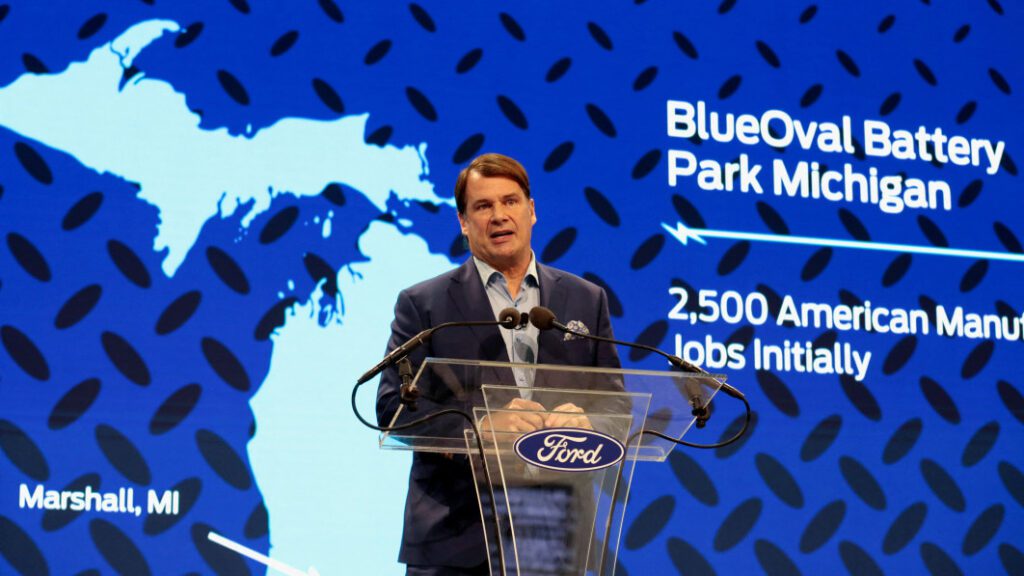Ford CEO Jim Farley on EV transition: 'Batteries are the constraint'

Companies such as Ford (F) are collectively pouring hundreds of billions of dollars into electric vehicles (EVs).
But as the industry transitions toward zero carbon emissions, battery supply chains could stand in the way of those ambitions.
“First of all, batteries are the constraint here,” Ford CEO Jim Farley told Yahoo Finance Live (video above). “Both lithium and nickel are really the key constraining commodities. We normally get those from all over the world — South America, Africa, Indonesia. We want to localize that in North America, not just the mining but the processing of the materials.”
Farley pointed out that even raw metals mined in the U.S. often get sent back to China to be processed, something the U.S. is actively trying to counter through grants and additional investments.
“The big change is going to be onshore all that capability of processing but also mining back in the U.S.” Farley added. “It will be a huge job, just like it has for semiconductors.”
In 2021, electric vehicles made up about 10% of all vehicle sales globally, according to the International Energy Agency (IEA). By 2030, BloombergNEF projects that half of all U.S. car sales will be EVs, spurred on by Inflation Reduction Act tax credits.
As demand for electric cars and trucks increases — and there would have to be an estimated 300 million electric cars on the road in 2030 in order to stay on track with benchmark net-zero goals — so too will demand for the precious minerals used in batteries.
That, in turn, could test the global supply chains that extract and process minerals.
The U.S. has outlined five minerals it deems “critical” to the EV transition that have supply chains at risk: lithium, cobalt, manganese, nickel, and graphite. Already, lawmakers and those in the mining industry have raised alarms about mineral supply.
“There’s going to be a real crunch to get the material,” Keith Phillips, CEO of Piedmont Lithium (PLL), told Yahoo Finance in September about lithium mining. Lithium is a key component in lithium-ion batteries, the most dominant type of battery used in the EV industry and the kind that Ford uses. The average electric car battery uses about 8kg to 10kg of the metal.
“We don’t have enough in the world to turn that much production in the world by 2035,” Phillips said. Notably, lithium-ion battery demand is expected to explode by more than 500% between 2020 and 2030.
Although the U.S. has developed some capacity for battery production, China dominates the market with more than 70% of global EV battery production capacity within its borders.
China is the largest producer of graphite, one key mineral used in lithium-ion batteries, but its strength comes mainly from its refining capacity. Once a raw material is extracted from the earth, it is sent to processors to purify the mineral, which is then sent to producers who manufacture the batteries that go into consumers’ cars.
Overall, raw minerals can travel as many as 50,000 miles before reaching a battery factory.
But as geopolitics, weather extremes, and spiking commodity prices threaten those supply chains, many U.S. automakers are making a concerted effort to shore up their own networks.
Ford announced in February another $3.5 billion investment in a new battery plant in Marshall, Michigan, as a part of its $50 billion global push toward electrification. The automaker acknowledged a $2.1 billion loss in its Model E electric division in 2022 and said it expects a $3 billion loss for the unit in 2023 as the company undergoes a restructuring and makes key investments in EVs.
“We have to get these materials from around the world until we localize the supply chain, which is what we want to do,” Farley said. “By the end of the year, we’ll secure all the raw materials to make the 2 million batteries by 2026 that we are going to need to go into our vehicles. We should be in good shape here.”
Yahoo Finance’s Akiko Fujita and Pras Subramanian contributed reporting.
—
Click here for the latest stock market news and in-depth analysis, including events that move stocks
Read the latest financial and business news from Yahoo Finance



